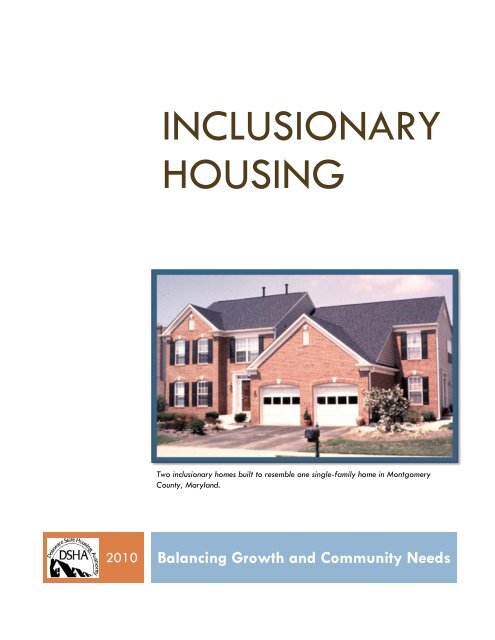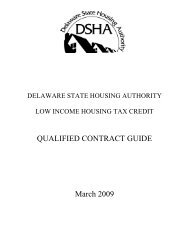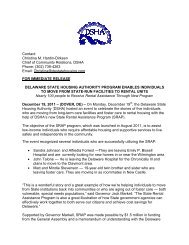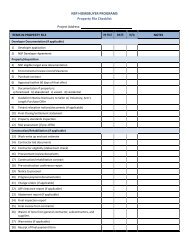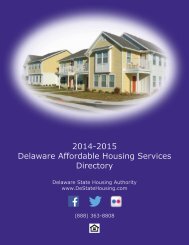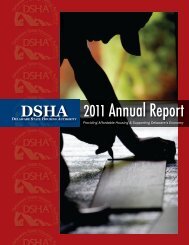Inclusionary Housing - Delaware State Housing Authority
Inclusionary Housing - Delaware State Housing Authority
Inclusionary Housing - Delaware State Housing Authority
- No tags were found...
Create successful ePaper yourself
Turn your PDF publications into a flip-book with our unique Google optimized e-Paper software.
INCLUSIONARYHOUSINGTwo inclusionary homes built to resemble one single-family home in MontgomeryCounty, Maryland.2010Balancing Growth and Community Needs
<strong>Inclusionary</strong> <strong>Housing</strong><strong>Inclusionary</strong> <strong>Housing</strong>B A L A N C I N G G R O W T H A N D C O M M U N I T Y N E E D SWHAT IS INCLUSIONARY HOUSING?<strong>Inclusionary</strong> housing (IH) programs or ordinances, also called inclusionary zoning, require or provide incentivesfor the creation of affordable and moderately-priced homes in new developments. Communities can use IHand their local zoning powers to counter declining public-sector investment in affordable housing, createhousing for their workforce, and enable low- and moderate-income families to benefit from urbanreinvestment and new development.<strong>Inclusionary</strong> housing ordinances can be either mandatory or voluntary. If mandatory, a density bonus, whichallows a developer to build more units (at a higher density), is typically provided to offset the costs to thedevelopers associated with building the affordable units. Voluntary programs provide density bonuses inaddition to other development incentives, such as relaxed regulatory standards (such as parking reductions),fee waivers, expedited review, and other incentives.THE NEED FOR INCLUSIONARY HOUSINGThe early years of this decade of strong economic growth brought an alarming increase in home prices in<strong>Delaware</strong>. <strong>Housing</strong> costs, especially home prices, rose far faster than incomes, quickly outpacing the budgetsof low- and moderate-income families. Further, new development in this time period focused almostexclusively on high-value homes, much of it in newly suburban or rapidly developing rural areas, cut off fromother communities and services.The logic behind inclusionary housing programs rests on three core ideas:1) New development should include a variety of housing types at a variety of price levels to meet thefull range of a community’s housing needs and demand.2) When being awarded increased density, zoning changes, public services, infrastructure expansion, it isfair for a jurisdiction to require the inclusion of affordably-priced homes in response to communityneeds. This need not disrupt the overall development plan.3) Affordable housing should be located strategically to create economically-integrated communities thatallow households of modest means access to equal opportunities.Jurisdictions can use IH as a tool to meet the housing needs of the "workforce households", households withincomes below 120 percent of area median income. IH allows the creation of affordable housing units withoutisolating low- to moderate-income households into economically segregated communities and withoutsignificant direct public cash subsidies.Page 1
<strong>Inclusionary</strong> <strong>Housing</strong>BENEFITS OF INCLUSIONARY HOUSING<strong>Inclusionary</strong> housing programs can expand the supply of affordable housing by encouraging or requiringdevelopers to incorporate affordable units – at affordability levels defined by the jurisdiction, in response toits housing needs and without adversely affecting the profitability of the development - in market-rateresidential developments. This technique can benefit the community in the following ways:Creates mixed-income communities that can help avoid the problem of over concentration, isolation, andstigmatization of affordable housing. Mixed income communities enable moderate- to low-wage earning families to buy homes inappreciating housing markets, have access to well-funded schools, livable wage jobs, and strongmunicipal services. IH programs help build a diverse housing market and ensure that residents who work and serve inthe community can live there as well. Communities that can provide housing to their employees canbetter attract and retain businesses and benefit from a resulting reduction in commute times, airpollution, and congestion. IH allows the development of affordable housing to become an integral part of otherdevelopments taking place in a community.<strong>Inclusionary</strong> policies can help to reduce displacement of existing residents unable to afford rising homeprices and rent; in appreciating housing markets, moderate- to low-income households are the first to bedriven out. Senior citizens have the choice to remain in the communities where they have raised their children. Young families and first-time homebuyers can buy a home in the community they grew up in.Does not require the expenditure of Federal, <strong>State</strong>, and Local tax dollars to fund the construction ofaffordable housing units. Jurisdictions can use IH to bring private residential developers into efforts to share theresponsibility of creating affordable housing. IH can empower communities with limited financial resources for subsidies to create affordableand moderately-priced housing. Furthermore, developing an IH policy can spur collaboration among the private, public, andnonprofit sectors engaged in housing development.IZ promotes more compact development by raising allowable density, thereby reducing conversion ofopen space and lessening dependence on automobile travel (Growth Management and Affordable<strong>Housing</strong>). Additionally, by supplying housing that is affordable to people who work in the community allowsthem to live where they work eliminating long commutes. Furthermore, it counters the problems of sprawl.Page 2
<strong>Inclusionary</strong> <strong>Housing</strong>COMPONENTS OF INCLUSIONARY HOUSING PROGRAMSJurisdictions determine the structure of their program and can determine how affordable housing can occur.Developing an IH program for a community requires an understanding of the community’s housing needs andlocal housing dynamics and trends. A needs analysis can be used to identify populations in the community thatcannot afford housing. Once needs are determined, the jurisdiction can establish housing prices that areneeded for affordability, then establish an affordable housing goal. The program can be coupled withincentives, density bonuses, and long-term affordability restrictions.Mandatory vs. Voluntary <strong>Inclusionary</strong> ProgramsMandatory inclusionary housing programs require developers to build affordable units in exchange fordevelopment rights. Voluntary programs are incentive-based and allow the developer to voluntarilyparticipate in the program and receive incentives in exchange for setting aside units for sale or rent belowmarket rate.National experience suggests that voluntary programs usually only produce affordable units ifthey offer substantial subsidies to the developer. Studies have shown that mandatory, ratherthan voluntary, inclusionary zoning programs are more effective at generating a larger supplyof affordable housing.Developer Incentives/Cost Offsets: A jurisdiction can provide developers with certain benefits tocompensate for the production of units priced at below market rate. These can be used in either voluntary ormandatory programs. Density bonuses are the most popular, but incentives can also include: Variances in landscaping, parking, buffers and other requirements; Expedited permit process; and Waiving fees that are associated with the development process.Set-Aside Requirements: A set-aside is the percentage of units within a development that a developer isrequired to price as affordable. Around the country, set-asides range from 5-35%. For example: Montgomery County, MD specifies that 15% of the units for sale in each subdivision of 50 or moreunits be made affordable to moderate-income residents. Boulder, CO specifies that 20% of the units for sale on a site larger than 10 acres or containing50 or more dwelling units be made affordable to moderate-income residents.Income Targets: A key decision in the program planning process is identifying the target population. This willaffect many other issues, such as whether rental and/or homeownership should be included and requirementsfor the size or type of units. Jurisdictions interested in creating housing for moderate-income households, oftenreferred to as workforce housing, typically set an income target between 80%-120% Area Median Income(AMI).Some jurisdictions set their target income households between 50%-80% AMI for lower-income wage earners.The jurisdiction can determine the target income level by housing needs and goals in the community, but needsa balance with maintaining developer profit. To reach lower income households, a community may reduce thenumber of required affordable units or increase the cost offsets to the developers.Page 3
<strong>Inclusionary</strong> <strong>Housing</strong>Programs typically target homeownership units to households at 80 – 120% of AMI and rental units tohouseholds with incomes of 50 – 80% of AMI. To reach even lower income households (0-50% of AMI),several programs successfully combine their units with other public resources. This can be effective forhomeownership programs as well, such as downpayment and settlement assistance programs for buyers of IHunits.Period of Affordability: While no actual public dollars are typically spent to make IH units affordable, thejurisdiction is in most cases making some concessions – the cost offsets, density bonuses, etc. – that have oftengreat value. Preserving that investment is vital, and thus most IH programs require that affordable unitsremain affordable to subsequent buyers and renters for an extended period of time. This may range from 10years on the lower end to permanent affordability. Ensuring there is a term of affordability on the units willallow future generations to have the opportunity of homeownership even as prices continue to rise.Furthermore, having a term of affordability can avoid "flipping" for quick gains. Municipalities can applyresale restrictions to the affordable units to enable them to stay affordable for a long period of time or inperpetuity, for example: Community Land Trusts; Contractual agreements (recorded in the land records); and Deed restrictions on the property (also called covenants).Coupling <strong>Inclusionary</strong> Zoning with other housing assistance programs: Additional assistance fromhomebuyer programs allows households earning less than the AMI target to be eligible for IH units. Forexample: First Time Homebuyer Program; Second Mortgage Assistant Loan Program; Employer Assisted Program; Community Land Trusts; and Enable public agencies or nonprofit organizations to purchase and further subsidize inclusionaryunits.Design Standards: Towns can choose to actively control housing design using zoning and building designstandards that mandate how housing units should be built and placed within communities. Municipalities canchoose the requirements for how the affordable units may be designed. Some cases require that affordableunits be identical to market-rate units in square footage and design guidelines, others programs may set aminimum square footage and guidelines for affordable units. Developers may also choose to create morelivable and sustainable housing, catering to new demographic groups like young professionals, aging babyboomers or others who desire more compact units that are affordable to their incomes.In-Lieu: An in-lieu fee can be an alternative option for a developer to pay the community a predeterminedsum of money “in-lieu” of constructing the physical affordable housing units on site. These monies are typicallyput into a segregated account for the community’s future to support development of affordable housing units(Financing Affordable <strong>Housing</strong>). Many communities direct in-lieu fees to local housing trust funds. It isimportant to note that fees must be high enough to discourage use and fully compensate for the cost of anaffordable unit; many communities impose restrictions on when in-lieu fees can be used. Communities shouldmake sure that in-lieu fees cannot be used as an easy or cheap way to avoid producing affordable ormoderately-priced homes as required by the ordinance.Page 4
<strong>Inclusionary</strong> <strong>Housing</strong>Here is an example of “Affordable <strong>Housing</strong> In-lieu Fees” from the City of Davis, CA: Eligibility:o Projects subject to the Affordable <strong>Housing</strong> Ordinance (development of five or moreunits);o Projects of 30 or fewer units and 10 acres or less as of January 1, 1989; ando Must demonstrate unique hardship due to size of the project, subject to the satisfactionof the Planning Commission of City Council. Payment:o $23,737 per affordable unit;o Fees are pro-rated, not averaged;o Fee adjusted annually based upon building valuation data; ando Fees generally paid upon Certificate of Occupancy for first market units. Use:o In-lieu fees are deposited into the City’s <strong>Housing</strong> Trust Fund;o Monies are used for loans to affordable housing projects, primarily developments ondedicated land; ando Loan repayments are returned to the Fund and recycled.For more information on the City of Davis visit: www.cityofdavis.orgCOSTS OF INCLUSIONARY ZONINGCosts to the Jurisdiction<strong>Inclusionary</strong> housing programs do not generally require the expenditure of local tax dollars and bear few“hard costs” for jurisdictions beyond the costs of administering the program. It is important to note, however,that inclusionary housing programs do require administration and long-term affordability and otherrestrictions require enforcement. Larger cities and counties with active IH programs and large inventories ofaffordable homes and/or rental units may have multiple staff members in program administration. It isimportant that communities considering inclusionary housing policies fully plan for their implementation andadministration. Costs that can occur might be lost revenue by providing offsets to the builders, such as feewaivers. However, studies have shown that the majority consent of jurisdictions have found IH to be a viableand cost-effective strategy for producing affordable housing.Costs to the DeveloperThe builder receives compensation for building the units by allowing increased density per acre or forms ofother incentives or cost offsets from the jurisdiction. Most IH ordinances have set compensations at a level thatallows builders to profit or break even from the construction of affordable units.Page 5
<strong>Inclusionary</strong> <strong>Housing</strong>COMMUNITY CONCERNSLike many affordable housing initiatives, IH can encounter opposition from some groups. There are solutionsand compromises that can help mitigate community concerns. Some commonly noted issues include:IH levies an indirect tax on developers, a "taking". Well-designed programs will include sufficient cost offsets to ensure that developers still make aprofit, or at the very least break even on IZ units.IH policies will slow down the housing market and prevent development. Studies have shown that communities with established IH programs have not indicated a slow downin the housing market. Furthermore, demand can be improved because people who weredisplaced from the market will now have opportunities to find housing.Burlington, VT: High Grove CourtMontgomery County, MDProspective homeowners in IH communities have contended that property values will be reduced if newcommunities include a mix of housing types and affordability levels. Studies have shown no effect of inclusionary housing or other affordable or moderately-pricedhousing on neighboring property values. These arguments are often rooted in simple NIMBYism.NATIONAL EXAMPLES OF INCLUSIONARY HOUSING PROGRAMSThere are hundreds of inclusionary zoning ordinances/programs nationwide, often forming in groups wherestate or regional policies and politics have supported their development. There are particular concentrationsof programs in New England, New Jersey, California, and the Washington, DC metropolitan area andsuburbs. Some key features of sample programs are included in the table below.LocationAffordableUnitsProducedThresholdSizeAffordableUnitsIncomes Incentives Fee/SiteOptionsBoulder, CO 300 All development 20%
<strong>Inclusionary</strong> <strong>Housing</strong>LocationCambridge,MAAffordableUnitsProducedThresholdSize131 10 units orprojects>10,000 sq. ft.AffordableUnits15% ofunits if>10 unitsor 15% ofsq. ft.Incomes Incentives Fee/SiteOptionsMust avg to
<strong>Inclusionary</strong> <strong>Housing</strong>Sussex County Rental ProgramIn 2008, Sussex County passed a rental program complementary to the existing MPHU homeownershipprogram. Like MPHU, the rental program is voluntary and offers density bonuses and expedited review todevelopers who include affordable rental units in new proposed developments. The target population ishouseholds with incomes of 30 – 80% of the county median. For more information, visit the County’s website athttp://www.sussexcountyde.gov/dept/communitydev/ .New Castle County Workforce <strong>Housing</strong> ProgramIn 2007, New Castle County created its Workforce <strong>Housing</strong> Program, part of several housing strategiesoutlined in its Comprehensive Plan. This voluntary program targets the creation of homeownership unitsaffordable to moderate-income households. Incentives for participation include generous density bonuses,building permit fee waivers, and some reductions in site requirements such as required open space, setbacks,lot sizes, height limits and landscaping. Developments must be served by public sewer and located in growthor redevelopment zones.In addition, fees associated with the program (a per unit fee as well as potential in-lieu fees) are directed toa new county <strong>Housing</strong> Trust Fund to support the creation of units for very low income households. A frequentlyasked questions document on the Workforce <strong>Housing</strong> Program is available athttp://www2.nccde.org/landuse/documents/PlanningFAQDocuments/Workforce%20FAQ.pdfTown of BridgevilleThe Town of Bridgeville also created an inclusionary housing program in 2006. This program, which ismandatory for all new annexations, targets the creation of homeownership units priced below $225,000 formoderate-income households. Current residents of Bridgeville, employees of Bridgeville businesses orinstitutions, or organizations providing emergency services in Bridgeville all have priority for units. As costoffset, the town waives the wastewater fee. Ten year resale restrictions on the units are required. Currently,participating projects are all large-scale developments with lengthy build-out times. There are an estimated250-300 units in the pipeline for creation.IMPLEMENTING INCLUSIONARY HOUSING[This checklist was written by Peter Werwath of The Enterprise Foundation, under a contract with the City ofSanta Fe, New Mexico, in 1994 and updated in 2004. Copyright 1995 The Enterprise Foundation]A Program Design Checklist1. Will the program be mandatory or “voluntary”?2. To what class or residential developments will the program apply?Single-familyMulti-familyMobile homeThreshold number of unitsPage 8
<strong>Inclusionary</strong> <strong>Housing</strong>Other characteristics3. What income group(s) will benefit from the affordable housing?100% of Area Median Income80% of Area Median Income50% of Area Median Income30% of Area Median IncomeDifferent % to deliver depending upon category? (such as: 5% affordable if
<strong>Inclusionary</strong> <strong>Housing</strong>12. Can the housing be provided off-site?13. Can the developer make in-lieu contributions?LandMoneyOther in-kindWhat is the formula for deriving the value of the “buy-out”?14. When are affordable units or in-kind contributions to be delivered?Up-front?Staged pro-rata with rest of development?How is the time value of money accounted for?15. What minimum standards will the city have for an “affordable housing unit”Square footageAmenities16. What will be the duration of affordability controls on rental housing?Number of yearsWill there be a regulatory agreement?How will it be monitored and enforced?17. What will be the duration of affordability controls on for-sale housing?“Soft” second mortgagesRights of first refusalEquity sharingLand leases/land trustsIf some mechanisms require an intermediary owner, is that OK?18. Can the city use third parties?In any part of the negotiations?To monitor compliance?To hold and administer liens?19. Will the program administrator be given discretion in any of the following areas:To analyze the internal economics of each proposal?To assess and take into account the economic impact on landowner/developers?To analyze the impact of “outside” subsidies?To analyze the “efficiency” of requirements as applied on-site, off-site or in-lieu and to have thediscretion to dictate which should be provided?Page 10
<strong>Inclusionary</strong> <strong>Housing</strong>To take into account the desirability of social and economic integration?To analyze the desirability of the site for proposed affordable housing use? (such as services,transportation, etc.)To have the discretion to dictate the “type” of housing delivered: for-sale, rental, group home,shelter, and unit size?To have the discretion to dictate for percentage of affordable housing units to be delivered invarious price classes?Copyright 1995 The Enterprise Foundation. www.enterprisecommunity.orgREFERENCESAnderson, M. (2003). Opening the Door to <strong>Inclusionary</strong> <strong>Housing</strong>. Chicago, IL: Business and Professional Peoplein the Public Interest (BPI). http://www.bpichicago.org/documents/OpeningtheDoor.pdfBeen, V., Meltzer, R. & Schuetz, J. (2007) The Effects of <strong>Inclusionary</strong> Zoning on Local <strong>Housing</strong> Markets: Lessonsfrom the San Francisco, Washington DC and Suburban Boston Areas. New York, NY: New York UniversityFurman Center for Real Estate and Urban Policy. http://www.nhc.org/pdf/pub_chp_iz_08.pdfCity of Boulder, CO. Division of <strong>Housing</strong>: Planning and Policy.http://www.bouldercolorado.gov/index.php?option=com_content&task=view&id=2642&Itemid=838Brown, Karen D. (2001). Expanding Affordable <strong>Housing</strong> Through <strong>Inclusionary</strong> Zoning: Lessons from theWashington Metropolitan Area. Washington, D.C.: Brookings Institution Center on Urban and MetropolitanPolicy.Brunick, N., Goldberg, L., and Levine, S. (2004) Voluntary or Mandatory <strong>Inclusionary</strong> <strong>Housing</strong>: Production,Predictability and Enforcement. Chicago, IL: Business and Professional People for the Public Interest (BPI).http://www.bpichicago.org/documents/mandatoryv.voluntary5.06.pdfBurchell, R. et. al. (2000). “<strong>Inclusionary</strong> Zoning: A Viable Solution to the Affordable <strong>Housing</strong> Crisis?” NewCentury <strong>Housing</strong> 1:2. Washington, D.C.: Center for <strong>Housing</strong> Policy.City of Burlington, VT Department of Community & Economic Development.http://www.cedoburlington.org/housing/inclusionary_zoning.htmDowns, A., Ed. (2004). Growth Management and Affordable <strong>Housing</strong> Do They Conflict? Washington, D.C.:Brookings Institution Press.Equitable Development Toolkit (2007). PolicyLink. http://www.policylink.orgFinancing Affordable <strong>Housing</strong>. “Local In-Lieu Fees and Set-aside Fund” June 2003www.cityofdavis.org. City of Davis, CA.Montgomery County, MD Department of <strong>Housing</strong> and Community Affairs. Moderately Priced Dwelling Unit(MPDU) Program website.http://www.montgomerycountymd.gov/dhctmpl.asp?url=/content/DHCA/housing/housing_P/mpdu.aspPage 11
<strong>Inclusionary</strong> <strong>Housing</strong>www.mrsc.org/Publications/textadu.aspx Municipal Research and Services Center of Washington.“<strong>Inclusionary</strong> Zoning”. Washington 1992 – Report No. 22.Werwath, P. (1995). “<strong>Inclusionary</strong> Zoning: A Program Design Checklist”. Columbia, MD: Enterprise Foundation.RESOURCESBusiness and Professional People for the Public Interest, a Chicago-based public interest law and policycenter, has numerous publications on inclusionary housing programs and best practices in their developmentand administration. http://www.bpichicago.orgPolicyLink, a national research, advocacy and social justice organization, includes inclusionary housingprograms in its Equitable Development Toolkit and has provided technical assistance in several large-scaleinclusionary housing campaigns nationally. Its materials in the Toolkit cover many topics closely related toinclusionary housing, such as developer incentives, transit-oriented development, and preserving affordability.http://www.policylink.orgThe Innovative <strong>Housing</strong> Institute, a national inclusionary housing advocacy organization, organizes a semiannualnational conference on IH, provides technical assistance and research to the field. Numerouspublications are on its website. http://www.inhousing.orgThe Nonprofit <strong>Housing</strong> Association of Northern California has been involved in many local and county-levelcampaigns for inclusionary housing programs and their development. Its website is a helpful portal to thelarge world of inclusionary housing programs in California, home to over 150 inclusionary housing policies.http://www.nonprofithousing.orgPage 12


